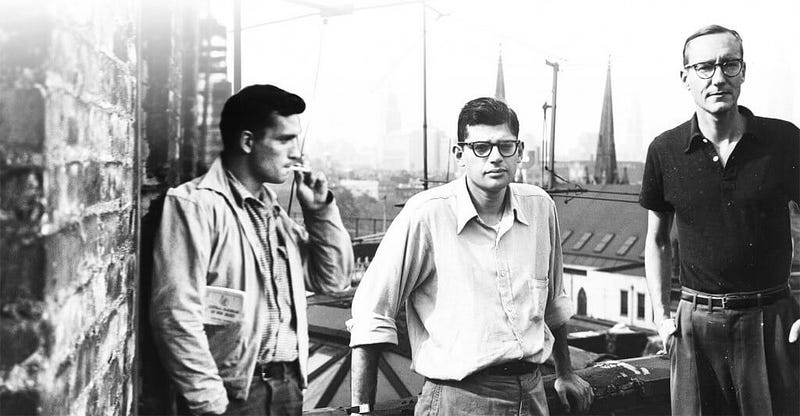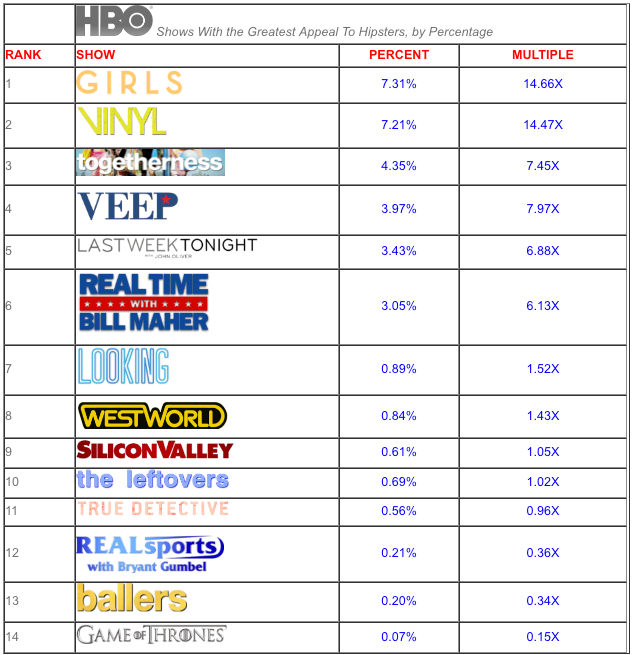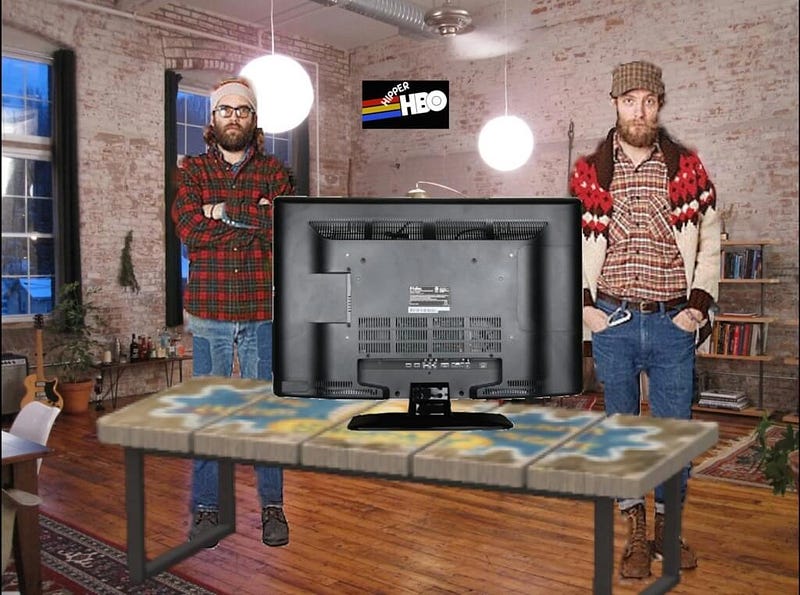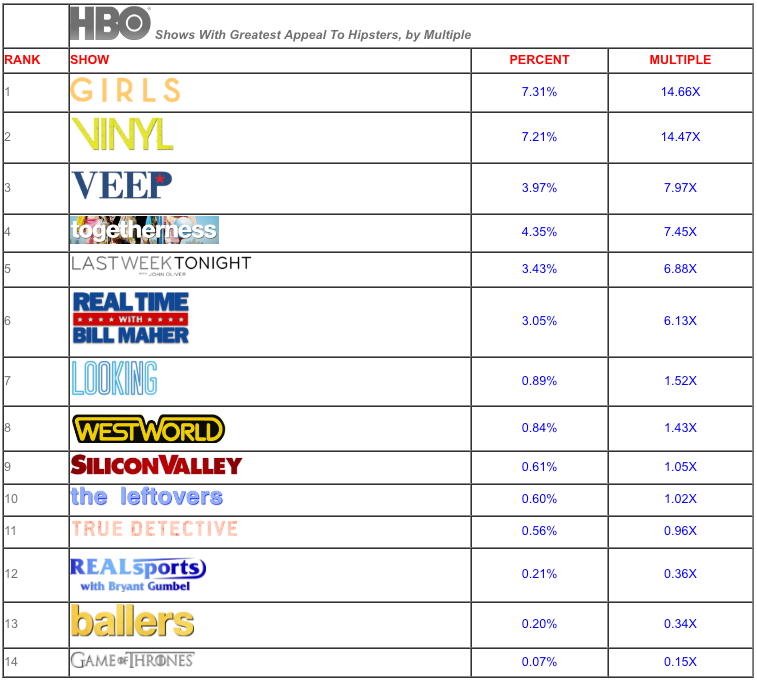HIPSTERS ARE REAL! AND THEY WATCH HBO! WHAT SHOWS DO THEY WATCH?
HIPSTERS ARE REAL! AND THEY WATCH HBO! WHAT SHOWS DO THEY WATCH?


Of course hipsters have the greatest affinity for the show ostensibly and specifically about them, Possibly some are too dense to grasp that it hardly celebrates the “lifestyle,” if you’d call it that, or too rich to see — now that many hipsters have joined the 1% — in the struggles and vainglorious actions of the show’s protagonists a piece of themselves. Who they were 10 years ago, no matter how tight their pants may still be, may not be so clear to them when reflected back at them. Hipsters are self-conscious, not necessarily self-aware after all.
As you know, we here at StatSocial analyze the habits, preferences, behaviors, likes, dislikes, and so forth of social media audiences; be they those who have come together of their own accord (such as the fans of an actor or politician), or those a StatSocial user has singled out and/or assembled for analysis (“Fleetwood Mac fans who also like mayonnaise, and live west of the Mississippi”? We can give you a whole massive stack of stats on that group, or any possible group you can imagine).
Here, using a secret sauce combining a vast array of interests in music, film books, fashion, food, and geographic location, we’ve within what we’re certain is a quite acceptable margin of error identified social media’s hipster population.
This group now identified, we could see to what degree they can be found among the social audience of each of HBO ’s most recent line-up of prominent original shows.
— — — — — — — — — — — — — — — — — — — — — — — — — — — — — —
Legendary Beat Generation novelist, Jack Kerouac, defined hipsters as “rising and roaming America, bumming and hitchhiking everywhere, characters of a special spirituality.”
In his seminal, and generation defining, and once wildly controversial poem Howl, fellow Beat writer Allen Ginsberg mentioned “angelheaded hipsters burning for the ancient heavenly connection to the starry dynamo in the machinery of night.”
The hipsters spoken of so rapturously, eloquently, and reverently a half-century-plus ago have nothing to do with the hipsters urbanites have been mumbling about since the early noughties.
Ten or fifteen years ago this jazz and/or Beat era term — once used to describe an individual who was as “with it” as they got, one who was “tuned in,” and one with a leg up on the squares — was re-appropriated and used almost exclusively derisively.
Instead of describing iconoclastic bohemians in the most romantic possible terms, it was used sarcastically and dismissively, and most frequently to describe a breed of mysteriously well-funded quasi-artists who came to dominate neighborhoods such as Williamsburg, Brooklyn in New York, and the Silver Lake neighborhood of Los Angeles. Thirteen years ago now, the sort was already ubiquitous enough in post 9/11 NYC, that satirist Robert Lanham had some relative success with a kind of updating of the early-80s wildly successful Preppy Handbook , with his own Hipster Handbook .
While dated by necessity, as no one could have anticipated the rise of the billion dollar Vice empire, or once hipster photog Terry Richardson getting paid $56 million in one year, or the general ubiquity of the odd combination of hipster detachment, nihilism, and navel gazing that runs through so much popular culture.
The modern day hipsters — meaning of the 21st century, as opposed to those Kerouac and Ginsberg wrote about — were vastly more contrived in their version of bohemia. It didn’t matter so much if they made art, just that they made it known they were artists. Deliberately wearing ill-fitting, out of date clothing, fancy, purposely over-groomed mustaches, and other accoutrements that would seem — in the early-00s — counter-intuitive to those pursuing “cool.” Therefore, making it cool. This phenomenon wasn’t a new game, of course.
But their gestures, you see, were ironic. As most of the rest of the world was not stupid, they got that part. But, they were neither impressed nor amused. Unlike their predecessors in nearly every other counter-culture and/or art movement of note for centuries, their gestures had no satirical, political, or philosophical underpinning. They were making no statement other than “look at me, I’m a fashion victim.” It seemed like they were just trying to be annoying for its own sake. They subverted nothing, they merely drove up the prices of old 70s concert t-shirts.
I’ll spare you the essay, but do recommend the film The Comedy , to show where it all usually leads in the end, and how the sight of this lifestyle aging is not always the prettiest.
In 2016, of course, while they dress very similarly, many of these sorts now are well employed. In fact, if they’re still in Williamsburg, they’d have to be. The once industrial wasteland is now one of the city’s most coveted addresses. Hipster now just means under-40, and fashion conscious in a particular way that embraces clothing both inhumanely tight and simultaneously rustic. A preference for foreign films, is as much of a given as is their presence at some cafe or well regarded diner for Sunday brunch. A taste for bands the media describes as “indie,” regardless of whether or not they actually record for a major label. And an overall pretense of a taste for the finer things — not highest class, mind you, but simply hippest — is usually not explicitly stated, but present enough for you to feel condescended to at most times.
So, if you were to say to your co-worker Chad — who plays banjo on the weekends, and claims to love “southern gothic” literature, but tends to trail off when you ask him to recommend some authors — “hey buddy, did you see last night’s Ballers ?” He might scrunch up his nose and say, feigning disappointment, “ohhh, I’m sorry I don’t know that one. I tend to prefer Togetherness and Transparent .” (The latter being an original series on Amazon Prime , which I’m sure we’ll be getting to in due time.)

A typical pair of hipsters in a Brooklyn loft watching HBO, which they prefer to do while standing and looking bored, as they do most things. Note in the background, a poster acknowledging a fondness for some of the network’s hipper programming.
Hipsters can surely still be layabouts, and most are definitely still in bands, but they are also often entrepreneurs, designers, writers, publishers, bloggers, and, well, you name a profession, and a hipster may be found somewhere in its most prominent offices. His sleeves may conceal his tattoos, and he may leave his mustache wax at home, but you can often smell ’em wearing an ironic cologne, like Hai Karate (joke, the brand is defunct, but hipsters would wear it otherwise).
While the author of this blog entry does not speak for StatSocial in general when he says he thinks Lena Dunham is talented, and Girls is a good (if not great) show. he also would have been surprised had it not topped this list. While in a somewhat biting and satirical way — whether held up as figures of fun or not — — Girls is a show about hipsters, in what we now consider the “classical” sense of the word. Of course it tops the list
As regular readers of the blog well know — and we encourage the unfamiliar to sniff around the blog and learn that there’s a whole lot more to StatSocial than just ferreting out hipsters — there are always multiple angles from which a social audience can be analyzed, and their character and truth discovered.
Perhaps our favorite alternate POV is that of the “multiple” metric. Instead of just straight up telling you what specific portion of a social audience is also members of another social audience, it calculates — weighing all the many unique facets of the audience being looked at in its analysis — and determines the likelihood of a member of the audience on which you’re focused also being a member of another specific audience. Or in this case — according to our scientifically determined criteria — a hipster.
O ur series of entries comparing Chick-fil-A’s audience to that of Shake Shack — which you can check out by clicking the underlined text — really illustrates how much the “multiple” metric can flesh out, or even just plain change the narrative.
In this case, a couple of shows switch places, but the narrative holds steady. They are most likely to favor the show which is about their sort. And then, in second place, they favor the show about what’s come to be the romanticized days of lawlessness, squalor, but also genuinely exciting art and music that was 1970s New York City. The show in question, Vinyl , was produced by Mick Jagger and Martin Scorsese, and was canceled after one season.
Nice work hipsters!

You wouldn’t, on passing glance, see this pair and think “they’re both really famous.”

Togetherness with its ties to contemporary independent cinema, with mumblecore pioneers the Duplass brothers at the helm is not a surprising show to see rank so highly on both lists. When sorted by multiple, VEEP does edge it out, though We’re not certain, but perhaps its roots in British series The Thick of It is a sufficiently obscure connection that hipsters can feel comfortable with the association, no matter how many Emmys it wins.
The big story here could be, though, that hipsters don’t even glance at Game of Thrones. If you saw our recent series of entries comparing the respective audiences of Netflix’s and HBO’s current line-ups and their respective tastes in both networks’ current line-ups (click the underlined text to check the entries out), you’d see that Game of Thrones is an unstoppable ratings juggernaut. Or so was our impression. Now we can only wonder how dominant GoT would have been in those surveys had the hipster population been filtered out.
( PLEASE NOTE: VICE , perhaps the company most responsible for spreading this plague , um, ahem… fashion and/or lifestyle and/or whatever it is globally, has its own HBO show. That show, however, does not have its own discrete social media presence. Therefore, it’s difficult for us to include them in this survey, but we suspect they’d rank highly if included.)
— — — — — —
To learn much more about StatSocial , the curious are encouraged to visit the StatSocial site itself, where you’ll find all sorts of stuff including sample reports.
— -
If you like what you’ve read, please take a few minutes to watch this overview of StatSocial’s data: